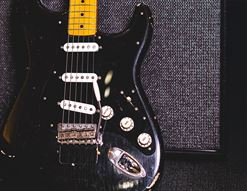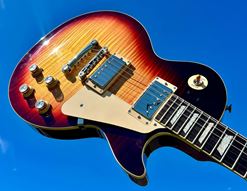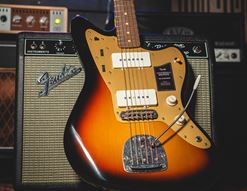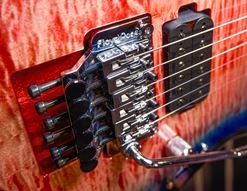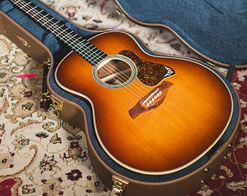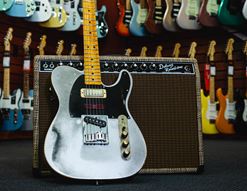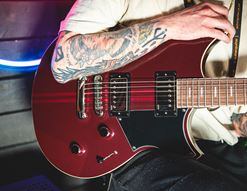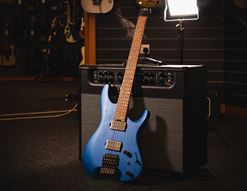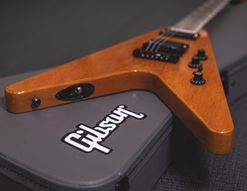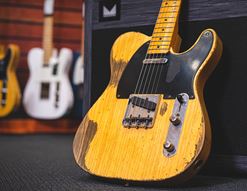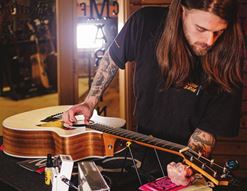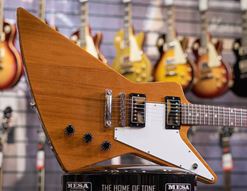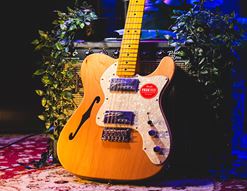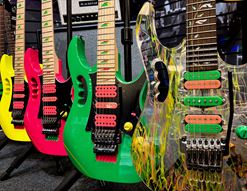We love guitars. We love playing guitars. We love listening to guitars being played.
But what actually is a guitar? And in just how many variations does the guitar come? Let’s take a look at types of guitars and break down their unique characteristics and features!
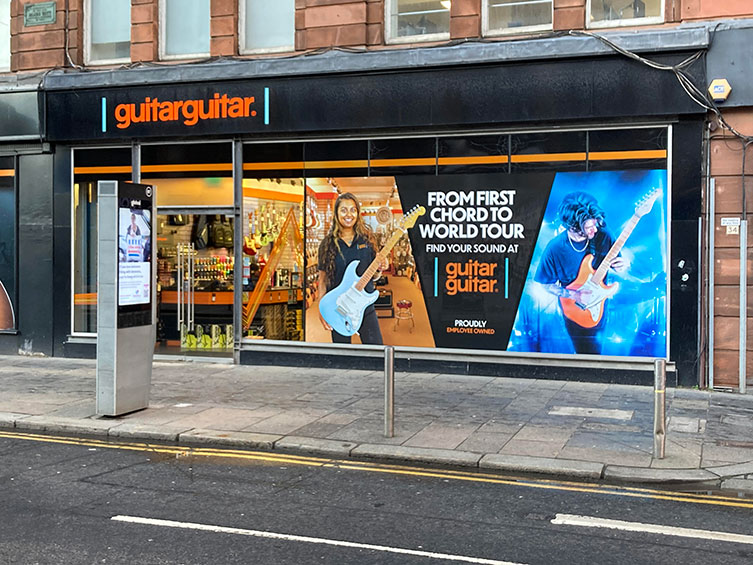
We’ll start off with a basic description which will be a common ground for all the types we’ll talk about today. A guitar is a fretted instrument made of wood which belongs to a stringed instruments family. It is a type of a chordophone - it produces a sound from vibrating strings stretched between two points. The guitar - in perhaps slightly odd shape and form - has been accompanying us humans since around the 13th Century. Its size, shape, playing techniques and application has evolved into modern times and it continues to do so. Whilst there are 3 main types of guitar: acoustic, electric and bass, we’ll try to dive a little deeper and touch on some important variations within those groups.
ACOUSTIC GUITARS

What is an acoustic guitar?
Acoustic guitar is a fretted musical instrument made with solid slices or plies of wood that form a body and a top. It is normally strung with steel strings and plucked by fingers or a plectrum. Acoustic guitar consists of a wooden top (solid or laminate on cheaper entry-level models) with a round soundhole, carved chamber made of a resonant tonewood (solid or laminate), bridge, bridge pins, neck, fretboard, headstock and tuning pegs. Its soundboard is supported by a construction called bracing, which is a series of sculpted wooden patterns formed into highly specific shapes. Bracing plays a huge part in the technical makings of a guitar's sound, with different bracing patterns offering tonal variations from instrument to instrument. An acoustic guitar is finally strung with steel strings made of bronze, phosphor bronze or nylon (classical guitars).
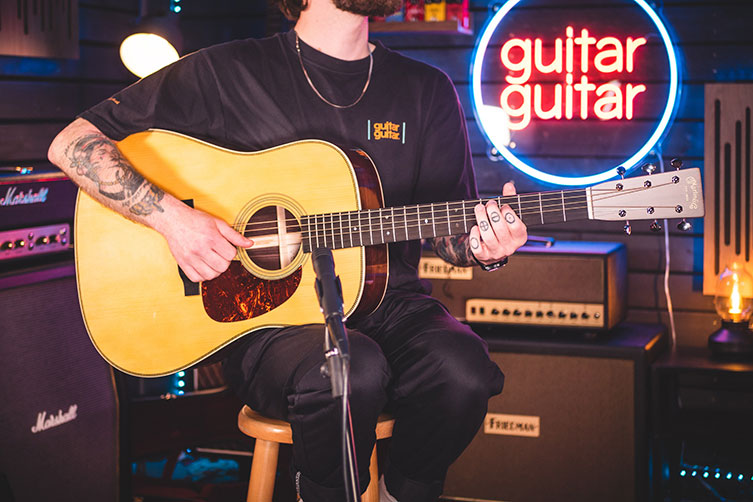
Laminate vs Solid
A question we often hear in the shop is: what is the difference between solid wood and laminate? Why does the price change so drastically from one to the other? The answer is very simple: The better the quality of timbre used in construction, the nicer the guitar will resonate. The sound will also improve with time, ‘seasoning’ the more it’s played.
A solid chunk of wood is susceptible to temperature changes. It opens up and shrinks and as it ages, it acquires a deeper colour and therefore a fuller sound.
Just like with furniture, there are products made with more affordable materials - laminate wood - to offer a budget option. Laminate wood does not have the same durability as solid wood and it doesn’t vibrate in the same manner. However, thanks to its construction it can often behave better in harsh environments and therefore bring less issues as compared to solid wood (humidity, dryness).
The majority of mid-range priced acoustic guitars on the modern market will offer a combination of solid top with laminate back & sides. A lot of manufacturers these days use HLP (High Pressure Laminate) a combination of wood fibre and natural resins to achieve an affordable yet durable structure in place of a solid wood.
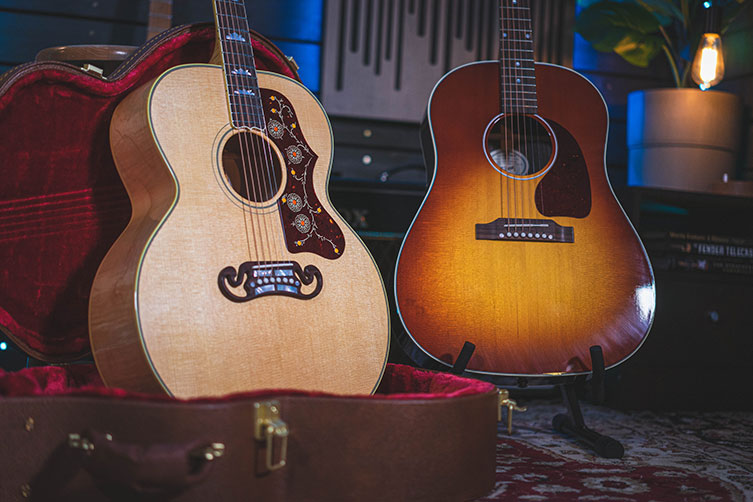
If you’re after an acoustic guitar with all-solid construction, you may be surprised but you don’t need to sell your kidneys (unless you’re after a high-end or boutique make). More and more luthiers offer solid-wood guitars at mid-range prices to combat the mass-produced cheaply made products flooding the supermarket shelves.
Tonewoods explained
When it comes to acoustic guitars, tonewoods they’re made of are just as important as the size of the guitar. After all, it’s the wood that determines the tonal flavour of the guitar. The basic rule of thumb is that the darker the wood, the warmer the sound it produces.
A great majority of acoustic guitars will have a spruce top. Spruce is light in appearance and balanced in sonic frequencies therefore it is deemed the most versatile. Its combination of elasticity and strength translates into a broad dynamic range with crisp articulation.
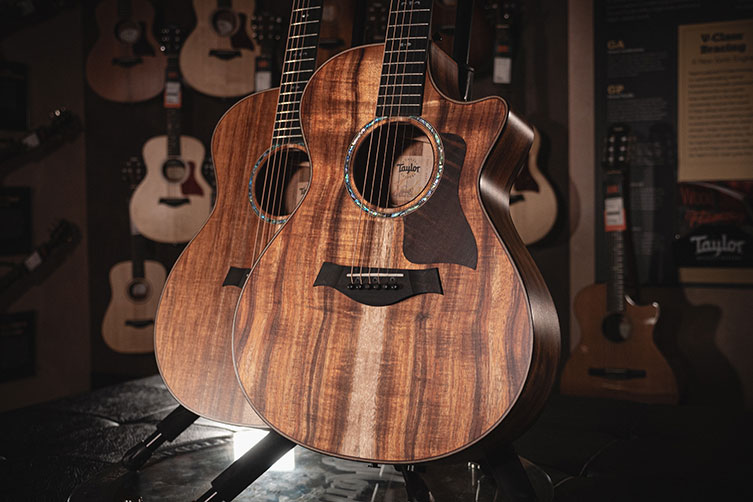
You’ll rarely find a cedar top (Lowden perhaps is that one brand which uses it equally regular as they do spruce on their acoustics). Cedar however, is a classical guitarist’s favourite. It is much softer in density and has a darker hue.
Then there is mahogany. The darkest of all three choices for tops, mahogany has the warmest sound, it controls the treble tones and balances the lows resulting in a mid-heavy, fuller tone all-round.
Although those are the dominant choices for tops on acoustic guitars, you may occasionally find a model with koa (Hawaiian exotic tonewood), flamed maple, redwood, walnut or something completely different on the soundboard!
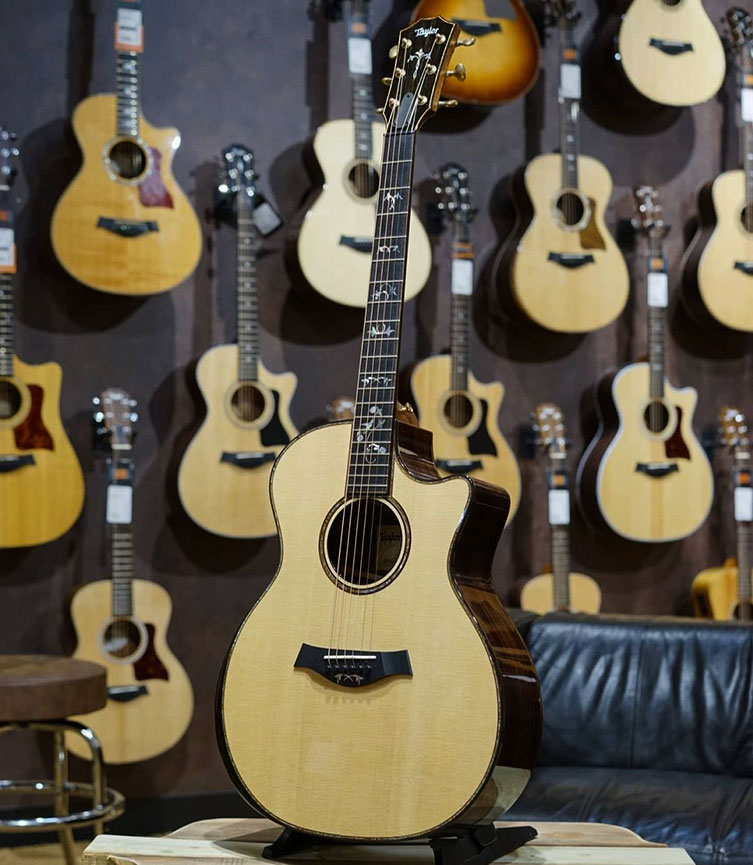
The back & sides of an acoustic guitar will very often be made of a different wood than its top. This has to do with construction, affordability of materials, the sound quality and general functionality of the instrument.
The most popular back & sides are made of rosewood. A guitarist who sings will appreciate the balance of the spruce and rosewood combination as it beautifully allows for the human voice to sit nicely in the mid range.
A player looking for the opposite, a guitar filling the midrange rather fully, will be very happy with a koa construction. For someone looking to achieve a warm and rounded low-end resonance, mahogany is the way to go, especially if matched with fingerstyle technique.
The modern market offers an impressive range of more exotic woods for builders to choose from when making guitar bodies/ backs and sides: ziricote, cocobolo, sinker redwood, big leaf maple, figured walnut and more!
What are the types of acoustic guitars?
Acoustic guitars come in many shapes and sizes.
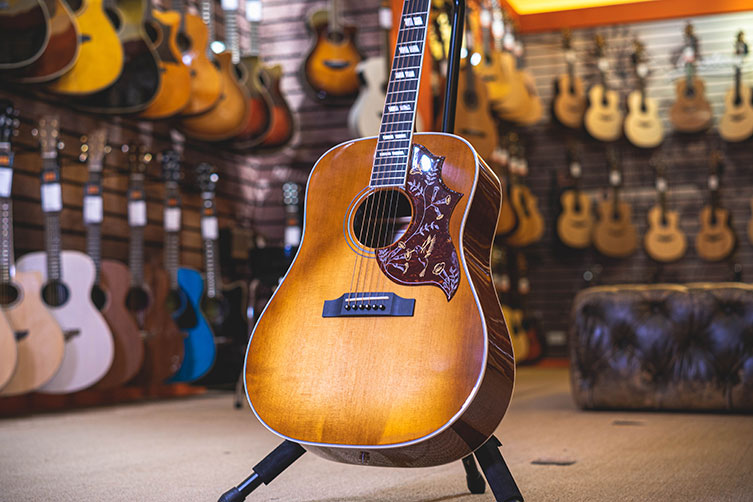
Your standard acoustic guitar is a 6-string instrument. If it’s meant for a small child, there is a ½ size, ¾ size or travel size option available. Size matters here mainly for comfort of the player. Nowadays we see a lot of adult players reaching for travel size guitars - not only have they been popularised by the likes of Ed Sheeran and Taylor Swift but they’re genuinely fun to play and easy to carry around!
It is to some extent true that the smaller the body of an instrument the quieter its sound. And vice versa, a big jumbo sized guitar will create a much fuller and louder sound. However, certain tonewoods can offset and compensate for the size as you will read in the following paragraph.
Probably the most recognisable shape of all goes to the dreadnought guitars. A characteristic pear-like shape has become everyone’s favourite. Invented by Martin in 1916 to resemble the mightiness of a Royal Navy battleship, HMS Dreadnought, Martin revolutionised the market of trendy, narrow-waisted parlour guitars, popular at the time. Parlour guitars were used for decades, played in rooms to an intimate audience, and so they didn’t need to be big or loud.
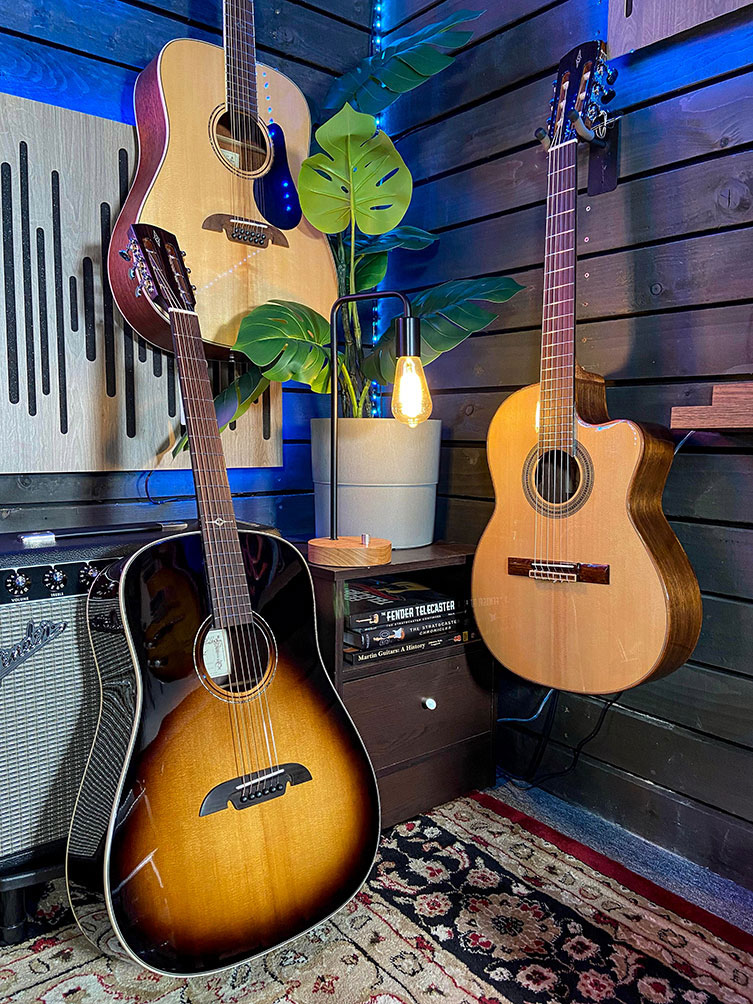
Concert shaped guitars come close in their size to classical guitars (though are of course steel stringed, rather than nylon). They’re compact and handy yet versatile. They're close in built to parlour guitars so you may come across various name tag for this body shape. Folk shaped guitars (also called OM by some retailers) quite often vary in size from smaller to bigger (grand auditorium). It is worth mentioning that the names of the shapes we’re discussing can be called different things from brand to brand. Some makers will have their own dimensions or depth on standard models and some will call them by symbols, proprietary names or numbers.
12-string guitars are simply an extended version of 6-string guitars. They’d be available in most body shapes and tonewoods as their regular equivalents. The idea behind a 12-string guitar is to achieve a 3-dimensional sound on one instrument: doubled strings tuned in octaves or unison create a chorus-like effect and a large wall of sound with intricate treble frequencies heard in a crystal clear way.
There are also 7- and 8-string acoustic guitars as well as baritone models, but these are specialised, far less commonly found instruments.
Each of the aforementioned shapes may come in its full form or as a cutaway (with treble-side upper bout carved to allow high-fret access). There are 2 main types of a cutaway: Venetian (rounded) and Florentine (sharper).
A great number of acoustic guitars can come equipped with pickup or a preamp - which would classify them into what we call electro-acoustic guitars. They share the same exact characteristics as their fully acoustic models except you can plug them in!
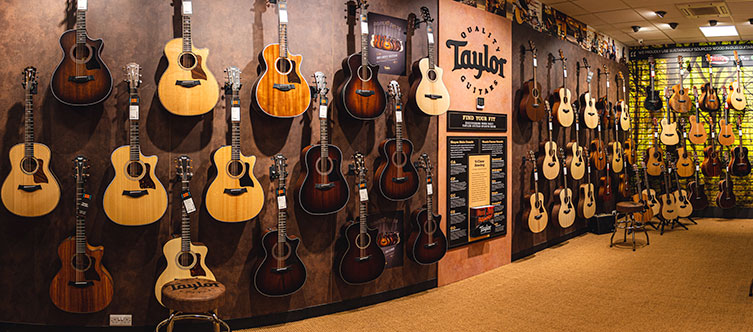
Depending on your needs and playing style you’re wanting to perform, there will be a few factors to consider when choosing your perfect fit. After all, it is all down to personal preference!
Who is an acoustic guitar for?
The answer is simple: virtually anybody. Depending on what style of music you’re wanting to play, whether you’re a beginner or advanced player, hobbyist or a professional musician, an acoustic guitar is for you!

Classical Guitars
Classical guitars deserve a section of their own. Although they are part of the acoustic guitar family, classical guitars are a thing of their own. Strung with nylon strings instead of steel, they don’t always have a truss rod and are constructed around a bigger heel (the rear joint between the neck and the body). As a result, classical guitars are much lighter in weight and resonate in a somewhat softer manner. Flamenco guitars (type of classical guitars) are quite specific, too: they come with low action (buzzing is wanted) and are mainly made with thinner, cypress wood top.
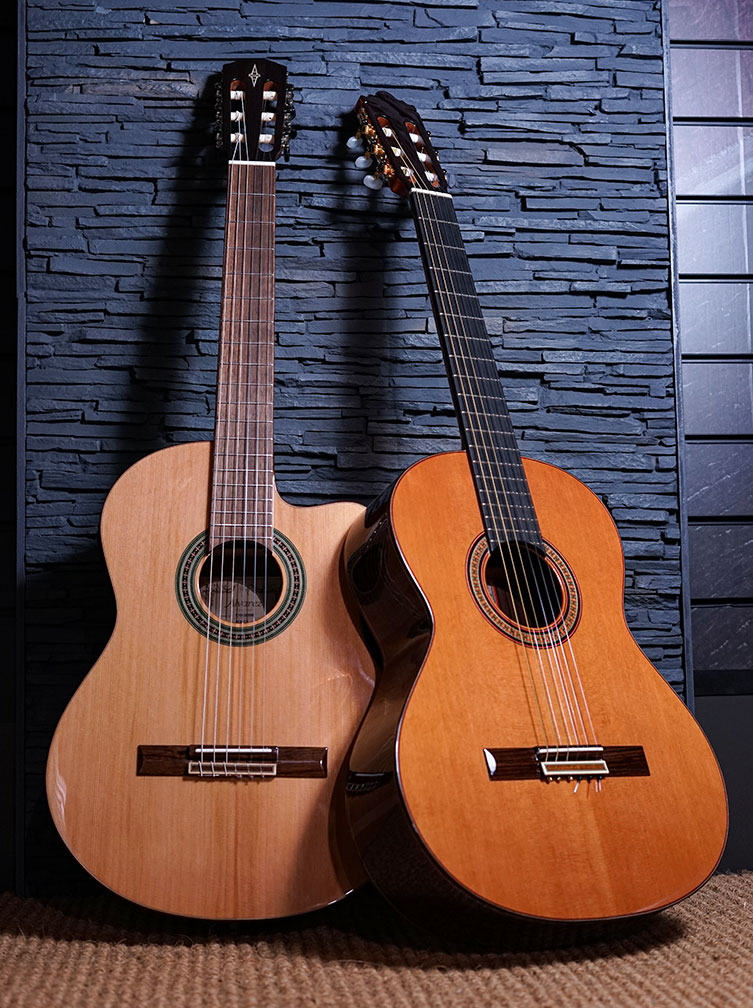
Who are classical guitars for?
Classical guitars are the right choice for classical or flamenco players. Many jazz and folk guitarists use nylon strung guitars in order to achieve a softer tone when plucking.
Classical guitars come in a lot of smaller-sized models, from ½ size to ¾ and 7/8, making it an easy choice for children. Nylon strings can feel softer under a young person’s finger which makes them a parents’ preference, however, this doesn’t always translate into easiness of playability. As classical guitars tend to have a much wider fretboard than steel string acoustics or electrics, making chord shapes a challenge! We tend to encourage the player to try a few different guitars before they make their choice.
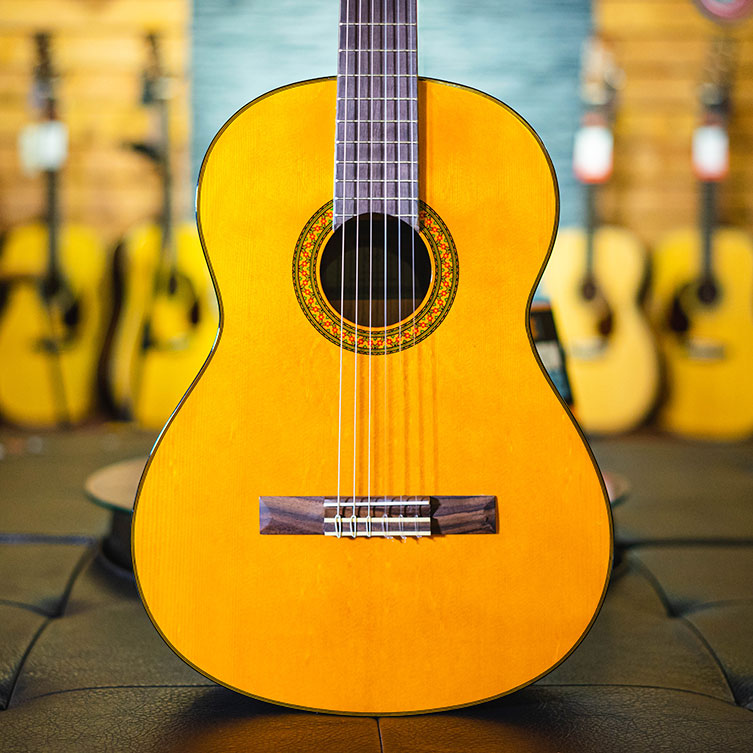
Resonator
These may look like quite an oddity but Resonators are basically guitars with a metal cone on top of the soundboard. This cone’s function is to help the guitar resonate better and amplify the sound, producing a loud and clear tone - the resonator is what creates the sound, rather than the hollow inner body and bracing. Resonators were invented as a response to the big band brass section (regular acoustic guitars weren't loud enough to cut through the powerful reed-driven instruments) and were intended for jazz originally. With the growth of other genres in popular music, resonators quickly became folk, blues and bluegrass favourites.

What is interesting about resonators is that they can be surprisingly versatile: you can get them with either traditional wood bodies or metal/brass ones and their necks can be either round or square. The square neck models have a significantly higher action and are meant to be played with a slide or a tone bar.
Who is a resonator guitar for?
Resonators require some level of playing and understanding of string instruments therefore we’d say they are for intermediate or advanced guitarists. Resonators will fit perfectly into any blues, bluegrass, Americana or folk repertoire. Resonators can be a great addition to a recording artist who wants to create an extra rootsy texture with various sounds.
Hollowbody and Semi-Hollow Guitars
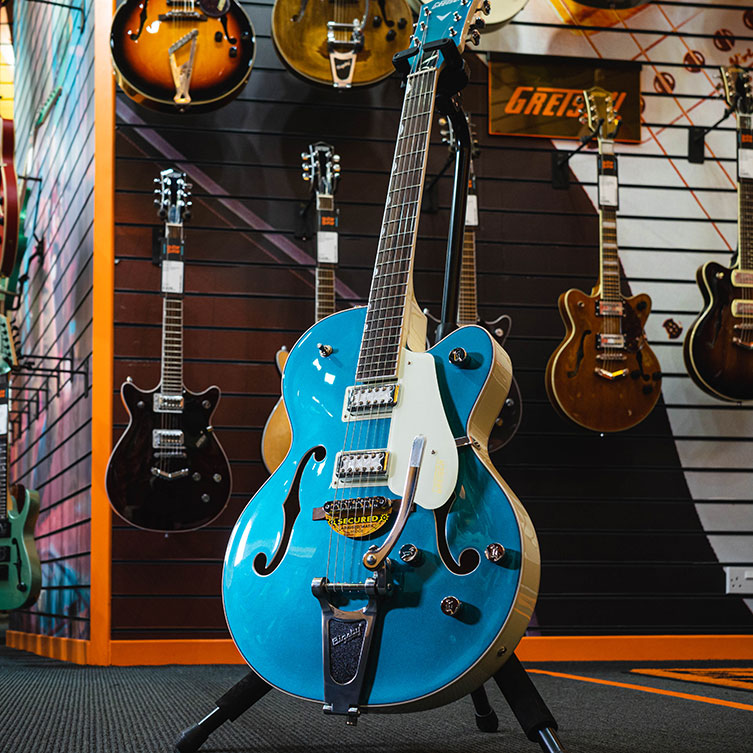
Let’s start off with the hollowbody, as it could easily be grouped into acoustic guitars as much as into electrics. Originally invented for jazz and played intensely throughout the 30s, 40s and 50s, hollowbody guitars have an arched top, characteristic f-shaped soundholes and their body depth is close to that of an acoustic guitar. These models were intended to be played acoustically, boasting a mellow tone yet a more sturdy frame. With new models appearing on the market, manufacturers were forced to add pickups onto these guitars. This resulted in feedback issues when plugged in (due to the hollow cavity of the instrument). Some players however, like to utilise this feature to their benefit, whilst others would swap to a semi-hollow model that shares some of the features and unique tone of the hollowbody yet limits the amount of feedback.
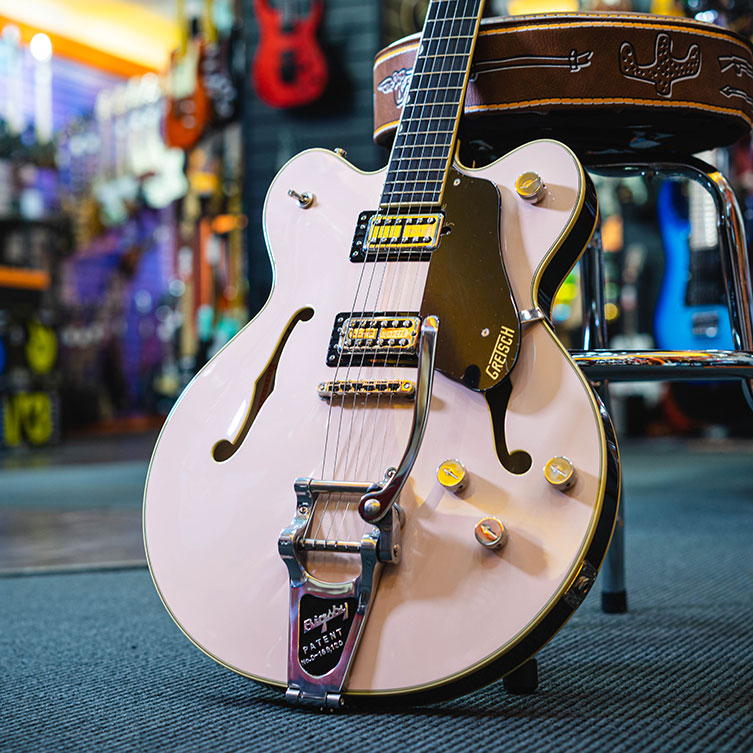
Semi-hollow guitars differ from the fully hollow-bodied ones by what’s inside the cavity of the guitar. A semi-hollow guitar would normally have a block of wood running through the length of the body, reinforcing the construction and as a result, creating less feedback. The depth of the guitar itself is also much thinner than that of a fully hollow guitar.
To sum it up, both, hollowbody and semi-hollow guitars (also referred to as semi-acoustic) are electric guitars but with a hollowed-out body (e.g. Gibson ES-335, Thinline Telecaster, etc).

Who is a hollowbody or a semi-hollow guitar for?
A player looking for a mellower tone, vintage sound or a quirky look would be definitely happy with a hollowbody. Rockabilly’s favourite, you’re sure to turn some heads with something from Gretsch’s collection!
ELECTRIC GUITARS
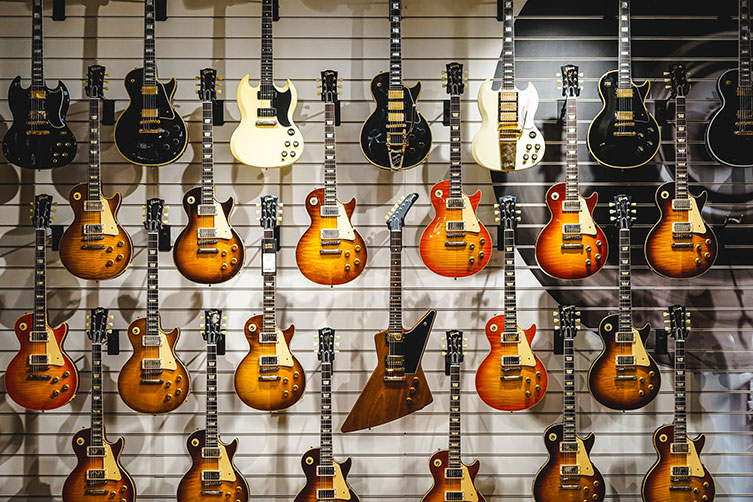
What is an electric guitar?
Invented in the early 1930s, an electric guitar is typically a solid wood instrument with quite a slim body. Electric guitars come in many shapes and scale lengths. It requires external amplification in order to be heard loudly. The electric guitar uses one or more pickups which convert the vibration of metal strings into powerful electric signals. The tone and volume of the instrument can be controlled by either its knobs or an amplifier’s setting.
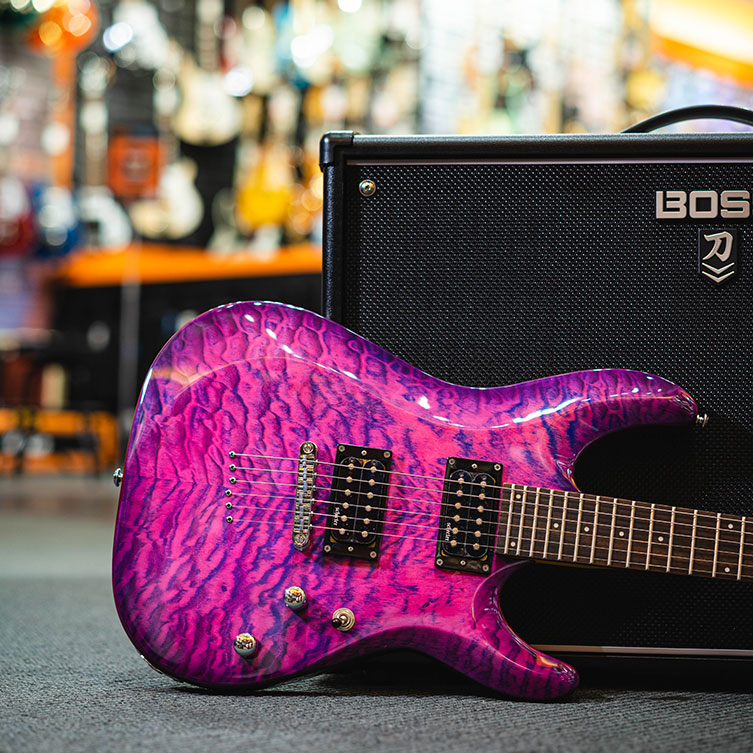
What are the types of electric guitars?
Now, there are as many models and shapes on the market as there are fish in the sea but if we were to classify them into groups, it would look something like this:
6-string guitars
The symbol of rock & roll, the icon of modern times: the six-string solid body electric guitar! We associate certain guitar shapes with specific genres or particular players and pioneers of a certain playing technique. It is safe to say that there is a guitar shape for each decade, defining its essence and reflecting cultural trends though most of today's most popular guitar designs are from the 1950s, and remain relatively unchanged from then. Traditionally tuned in 4ths - to EADGBE - a six string guitar is easily one of the most popular instruments in the world!

7- 8- 9- string guitars / multiple-string guitar
An axe of choice for metal or hard rock, 7-string guitars (as the name suggests) have extra string added onto their bass side. This expands the range of the instrument and allows the player to create an extra texture and depth in the rhythm pattern. 7th string would then be tuned to B; in 8-string guitars the 8th string to F# (tuned in 5th here, instead of 4th to a G, in order to make playing chords easier) and lastly your 9-string axe’s 9th string would be tuned to C# and the scale here will be lengthened.
12-string guitar
Just like acoustic guitars, electrics also come in 12-string versions. Each string comes with a pair: the pair for low E, A, D and G are tuned in octaves whereas the high E and B are tuned in unison. This creates a ringing, chorus-like effect and a thicker, louder sound. The gap between each pair of strings is very narrow. A 12-string electric guitar can be played using the same chord shapes and notes as you would on a regular 6-string guitar although advanced techniques may be required to make the most of the instrument. Hence this wouldn’t be the best guitar for a complete beginner but rather for someone with at least minimal intermediate skills.
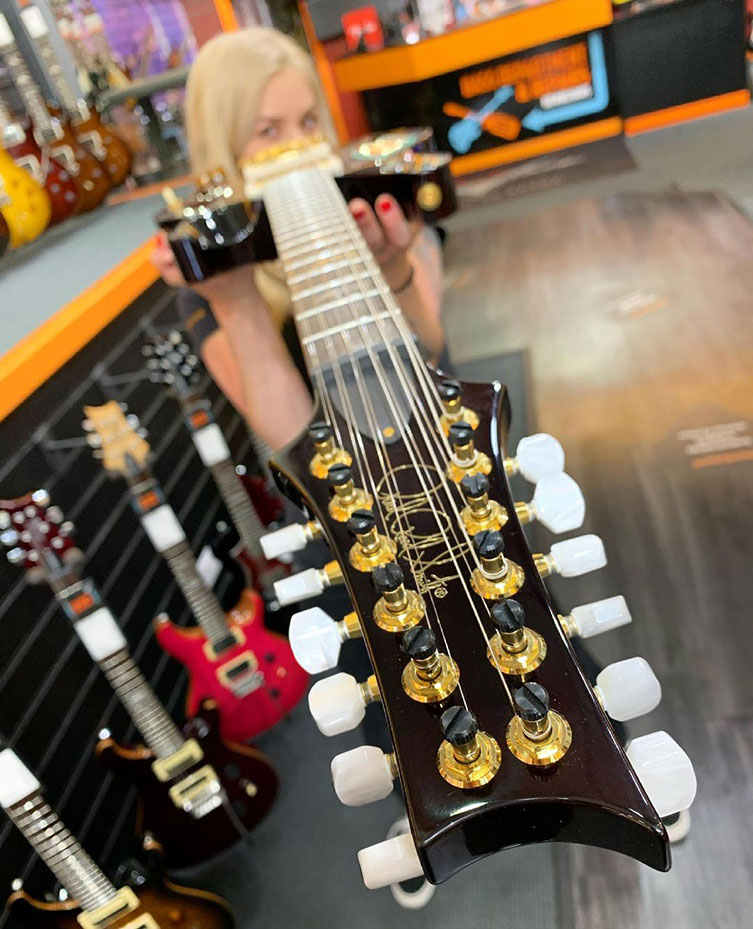
Baritone Guitars
Baritone guitars may look like a regular guitar but once you have it in your hands and strum you’ll notice some significant differences. Firstly, the baritone guitar has a larger body and a longer scale length (from 26” to 30”). This allows for the correct string tension required for lower tunings to sound accurately in pitch. Secondly, the baritone guitar is tuned to either A standard or B standard tuning. These features result in an overall thicker, bassier sound and make it a perfect choice for heavy music guitarists. However, baritone guitars are not at all an invention of modern times. It was first introduced in the late 1950s and used in many Western film scores as well as surf music!
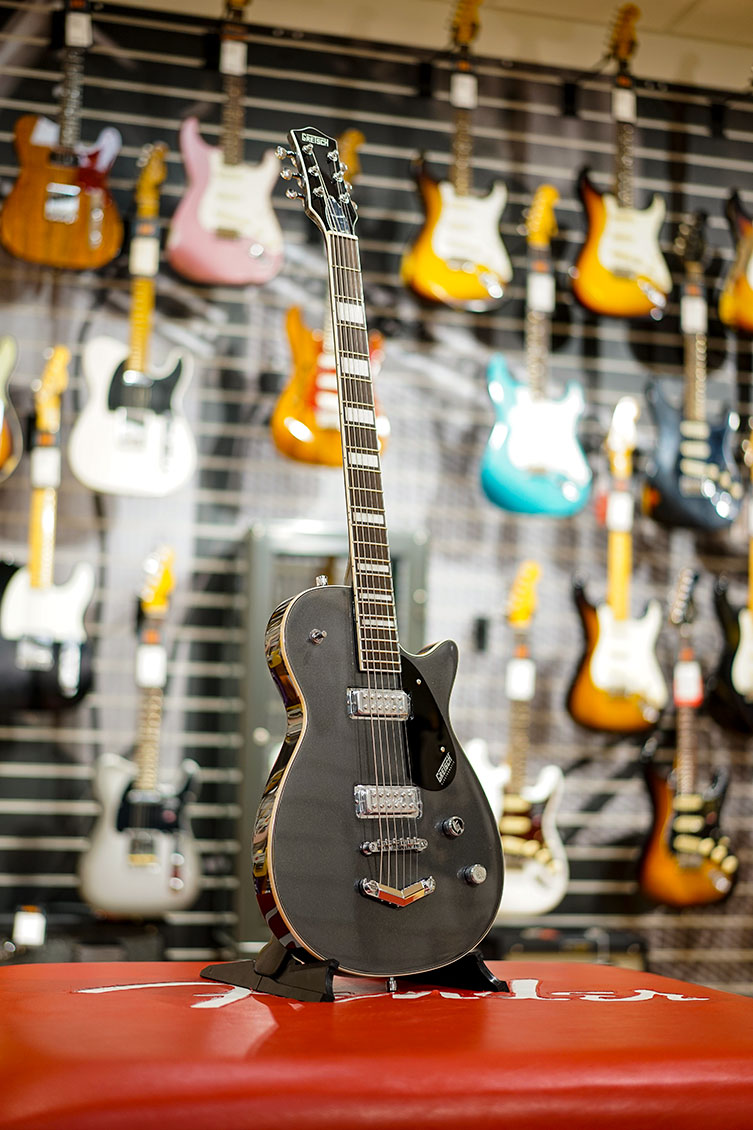
Who is a baritone guitar for?
This is a guitar for someone looking to add some tonal variety into their guitar collection; someone who wants a chunky tone without relying on bass too much. A player who enjoys experimenting with various stringed instruments will be delighted with what a baritone guitar can do!
Electric Guitar Shapes
Electric guitars will often be categorised into shapes. The most popular shape would be an S-style - after the Fender Stratocaster, with characteristic rounded 2 upper horns, usually fitted with 3 single coils (SSS) or a humbucker - single coil - single coil configurations (HSS). Depending on the brand, this type of guitar can be also named double-cut (dc).
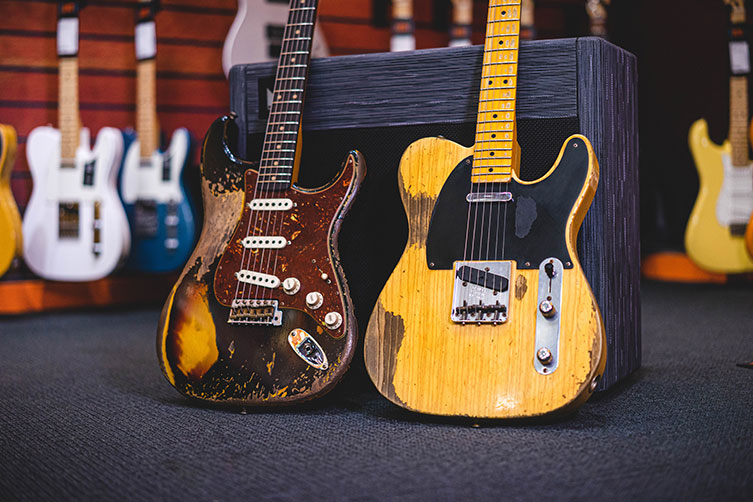
The second most popular type is the T-style guitar. Named after the Fender Telecaster, it imitates its proprietary design with single-cutaway on the treble side. This style can be often referred to as single-cutaway - sc (in Gibson family, e.g. a Les Paul).

Offset is a term that describes any body shapes that differ from the standard types (the 'offset' bit refers to the guitar's waist not being symmetrical). Again, a term coined by Fender, the offset family includes models such as: Jazzmasters, Jaguars, Mustangs, Duo Sonic, Meteora. In the Gibson / Epiphone family, the “offset” models would be Firebirds or Explorers, or Jackson’s own Kelly models.
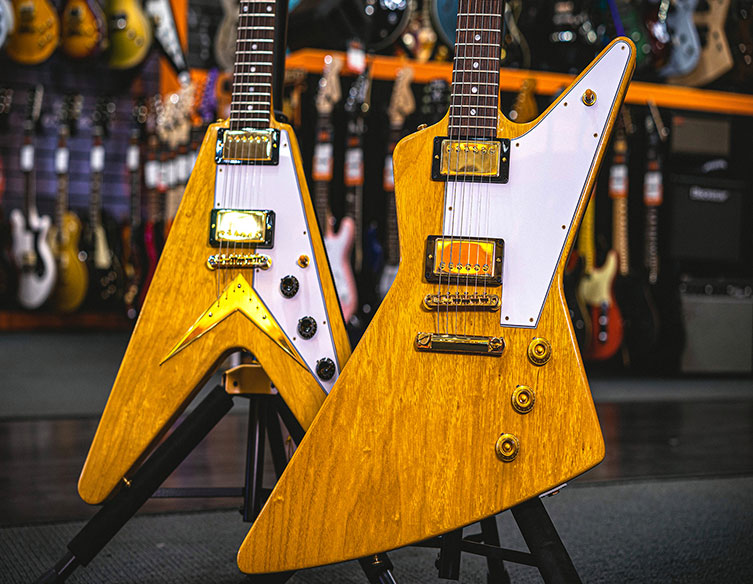
Quite an oddity in its own right, the Flying V. Metal and hard rock’s favourite, this Gibson design was invented in the late 50s and it found its rendition across other brands (ESP, Solar, Jackson) due to a high demand for a spiky model!
Who is an electric guitar for?
Well, again it really is for everybody! With so many models and shapes and configurations, there is an electric guitar for any type of player out there. You can start off on an electric guitar - we see many beginners going straight for it as it would better suit their style and goals. Acoustic guitar usually tends to be the preference for beginners simply because it doesn’t require an amplifier and therefore makes for a cheaper option in case the person doesn't stick to it. If your dream is to play prog metal it only makes sense you choose electric guitar over acoustic. If you’re a seasoned acoustic player you may want to try and experiment with an electric guitar. Electric guitar opens up the world of effect pedals and the sounds you can create with them are almost limitless. Also, if you’re a professional guitarist you definitely need an electric and an acoustic guitar as these will be your working tools.
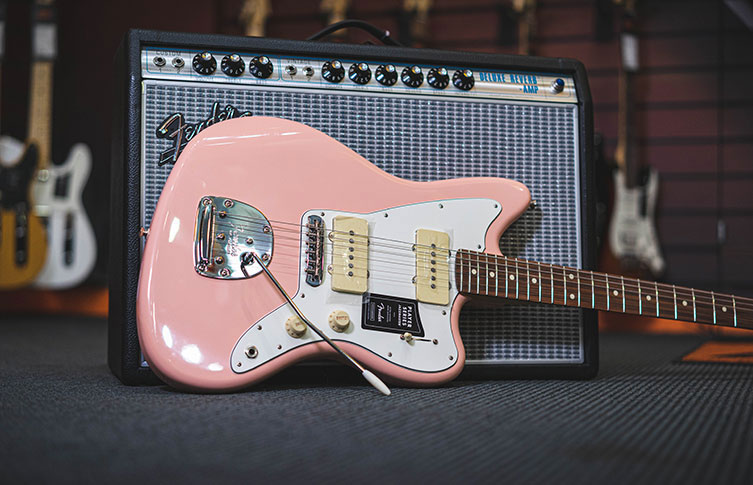
All in all, there is no wrong or right answer - guitars are for everybody!
WEIRD AND WONDERFUL
We’re dedicating a separate paragraph for the true oddities that have graced the guitar market over the years and proven their place by becoming hugely popular.
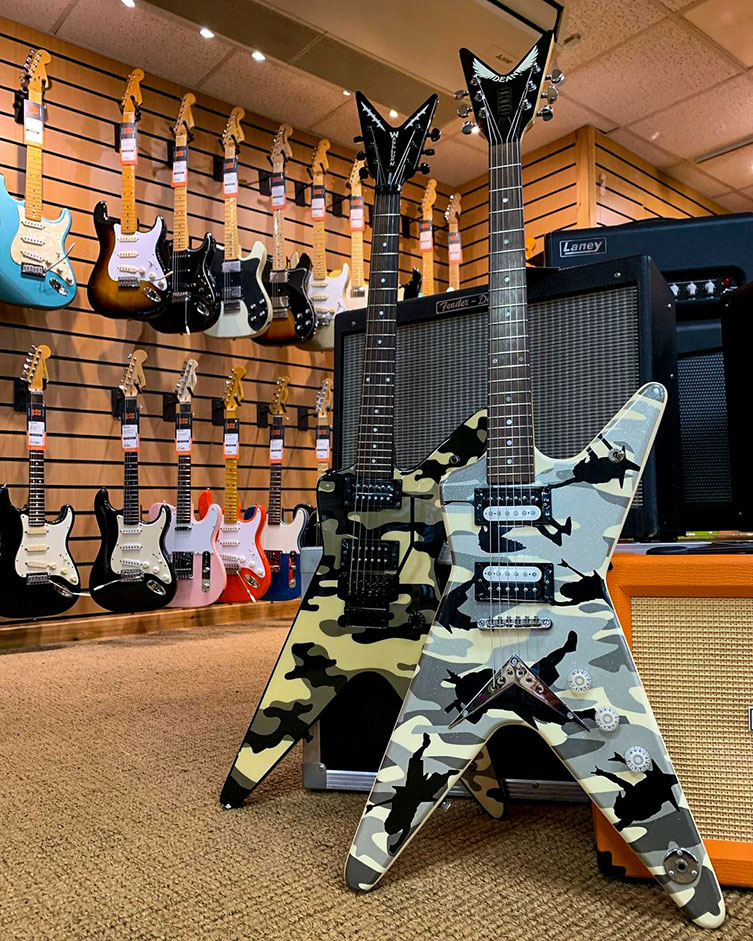
One such spot goes to the headless guitar. As the name suggests, it’s an electric guitar without the headstock, often matched with a “bottomless” lower bout cut in a straight line. Introduced in the 80s, it quickly found a fanbase amongst contemporary players who appreciate its ergonomic design and lightweight construction. The tuners of a headless guitar are located at the bridge, meaning the headstock is unnecessary. The strings are locked in place at both ends providing unrivalled tuning stability.
Rock icons love to show off their skills and larger than life personality and if you think an electric guitar should be cool enough then you’re wrong! A double-neck guitar is where it’s at, dear reader. Heck, maybe even a triple-neck or multiple-neck guitar, if we’re going this far! Vanity aside, these guitars actually have a very useful purpose. They allow the player to make a smooth switch between instruments mid-song! Basically, a double-neck guitar looks like 2 guitars stitched together. One neck can have 6 strings, the other 12. Sometimes it’s a bass! This creates a dynamic sound, especially if you’re using a looper pedal and let one “side” of the guitar ring out! You may also come across double-necks with 6 strings on both sides and have one in alternative tuning.
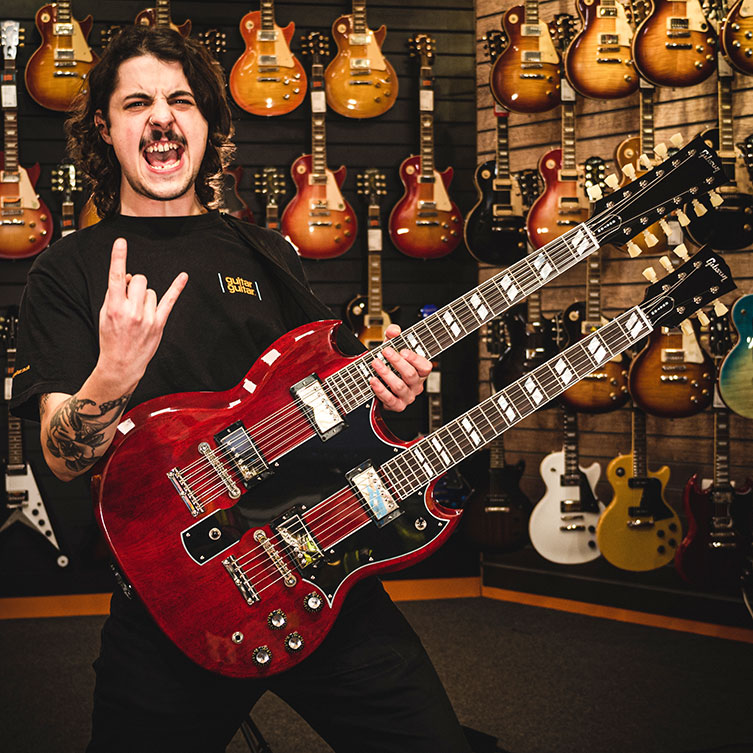
Now something completely different, a lap steel guitar. Also known as a Hawaiian guitar, it’s a slim bodied, solid-wood instrument which is played horizontally, placed across the player’s lap. The neck of a lap steel is large in width and the string action is high. There are no frets, only markers that resemble them for guidance. A lap steel is played by pressing down on the strings with either a slide or a tone bar.
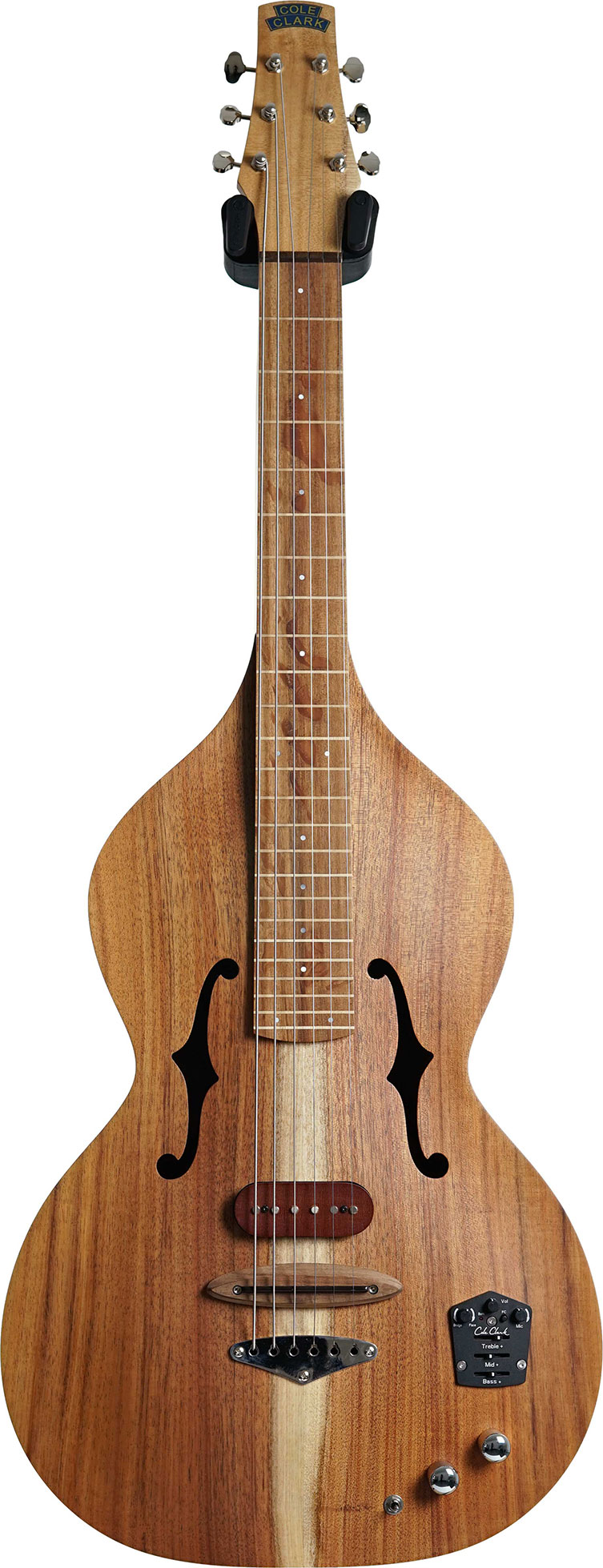
Understanding The Guitar Types Is Key
No matter what shape or style you pick, if you want to play guitar, it is important that you understand the different types of guitars. The right instrument for you depends on many factors, like what music you listen to and want to be able to imitate, what kind of sound you’re looking to get from your guitar and what type of a guitar feels comfortable in your hands (neck shape, scale length, fretboard radius, body size etc!). Ultimately, although it may seem like a vanity stance, we believe it is crucial that you like the look of your guitar simply because it will be an extension of your personality and a tool of creative expression!
BASS GUITARS
Although bass guitars have the word “guitar” in the name, they are actually rhythm section stringed instruments. While you can still play core elements of melodies on a bass, you’ll find that it follows the drumkit just as much as it does lead/rhythm guitar.
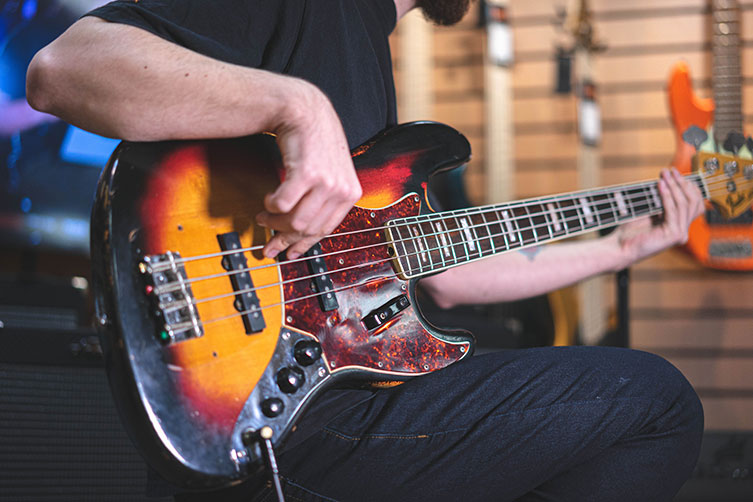
What is a bass guitar?
Bass is the lowest-pitched instrument of the guitar family. It is similar in appearance to an electric guitar (electric bass) or an acoustic guitar (acoustic bass) yet with a much bigger body and a much longer scale length and neck. Most standard bass guitars will have 4 strings, E A D and G, but there are 5-string basses and 6-string options, whatever your rocking heart can handle! An electric bass will require a bass amplifier - different from an electric guitar amplifier to accommodate for the powerful low-end frequencies!. A bass is played with index and middle finger, thumb (slap-bass technique used to achieve a more percussive effect) or a plectrum.
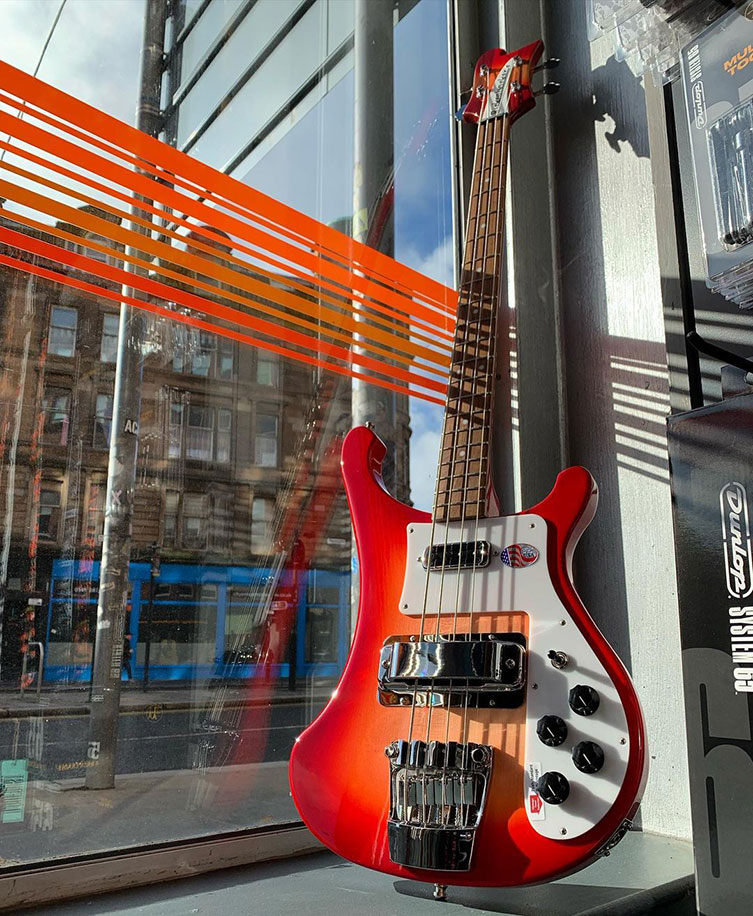
What are the types of bass guitars?
Traditionally, the bass is the biggest of string section instruments within an orchestra band. It is played upright, hence it is often referred to as an upright bass or a double bass. This type of a bass guitar is often used in modern Rockabilly/Psychobilly bands as it provides a one of a kind tone, unachievable with an electric bass.
Acoustic bass typically comes equipped with a pickup (electro-acoustic bass), but you can find a straight up acoustic model, too. Due to its low end tones, an acoustic bass would not have enough volume to cut through a band if unplugged.
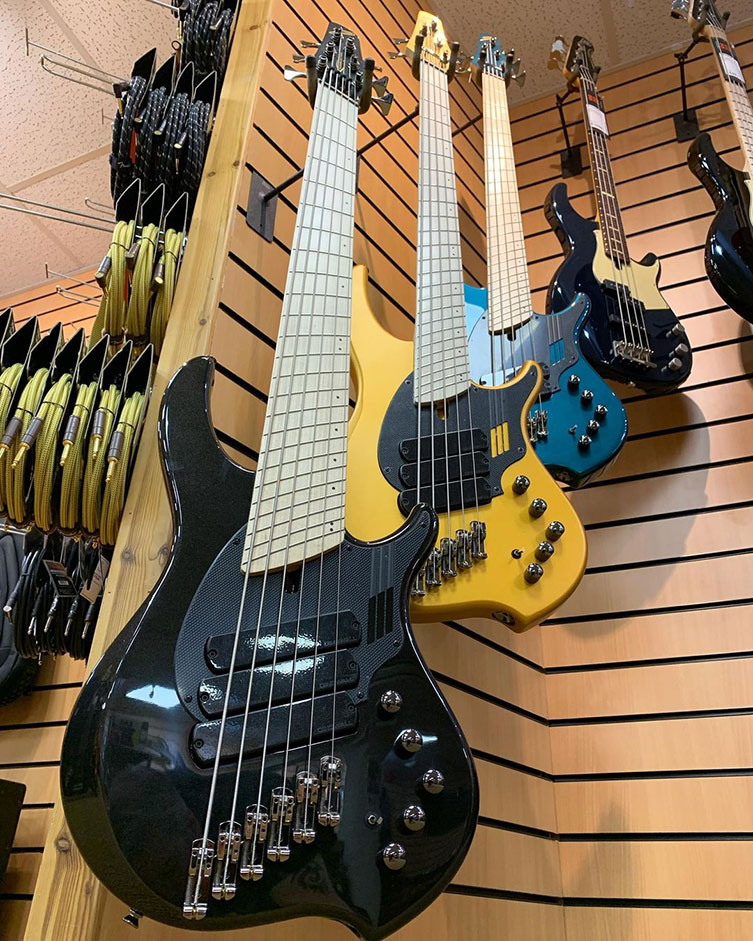
Electric bass was popularised in the 1950s by Leo Fender and his invention of the iconic P-Bass (Precision Bass) and then Jazz Bass. Nowadays, there are many varieties of electric basses in larger body shapes like Rickenbacker, or offset models such as a Thunderbird.
Many manufacturers offer 5-string basses or even 6-string basses for all your low-end needs.
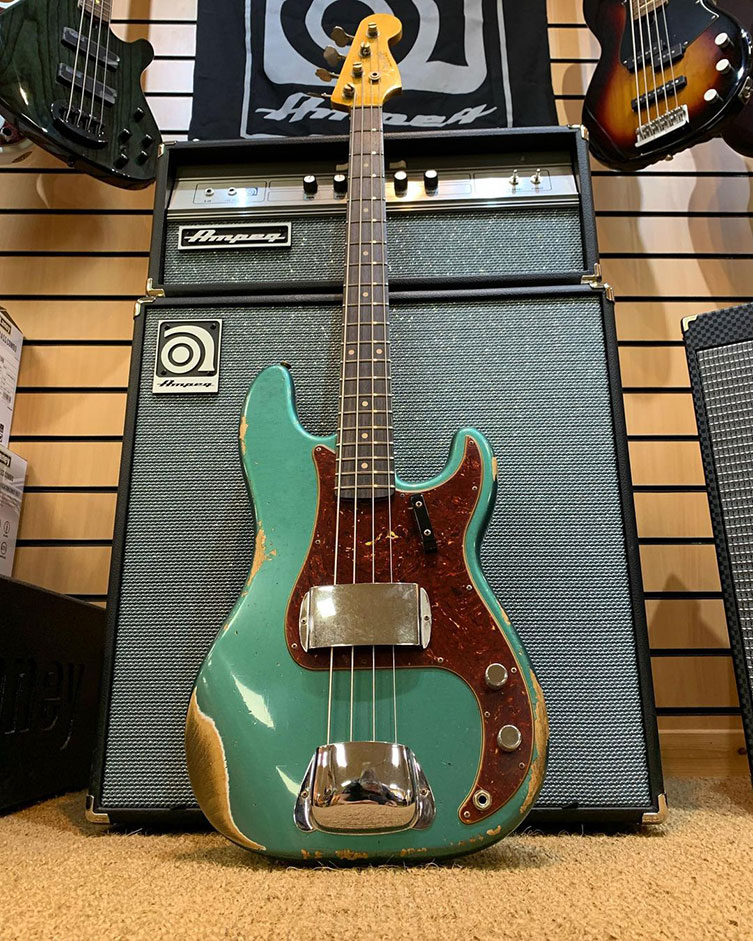
There are models with shorter scale lengths for children or adult players who find a standard length uncomfortable. One such example is Fender Mustang bass.
Who is a bass guitar for?
Bass can be played by virtually anyone who wants to! Bass is a great entry-level instrument for someone who is just getting into music or someone who is drawn to the rhythm more than the melody but doesn’t quite fancy a drum kit. Many guitar players tend to add bass to their arsenal of instruments and skills - and vice-versa - as it is often easier to learn a new instrument if you already play another. Bass is often a weapon of choice for someone who prefers grooving in the corner rather than taking the limelight spot on stage. Which doesn't mean you can’t do both! (check Flea for reference).

Final Thoughts
We are lucky we live in times when the guitar world is at the core of almost every musical piece. The variety of genres that emerged in the span of the last few decades called for constant changes and challenged luthiers worldwide to continue on improving their wooden inventions to satisfy those needs. When our parents in their teens could just about source a beaten up Fender copy, for us nowadays the world of guitars is our oyster! There really isn’t a type of a guitar that doesn’t exist. And if there is… we’re sure most manufacturers would be up for making it happen! Whatever type of guitar your heart desires, here at guitarguitar we’ve got it all. If you are unsure what guitar type would be best suitable for you, pop in to one of our stores, jump on a LiveChat or simply phone us and we’ll be excited to help you find the perfect axe!


